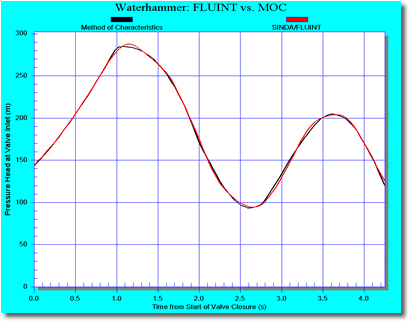Waterhammer, Acoustic Waves, and Other Fast Transients
Waterhammer is an impulse load created by sudden changes such as valve opening or closing. The resulting pressure loads can have catastrophic effects on pumps, pressure transducers, turbines, and valves. Waterhammer events typically occurs over a millisecond time frame, but may spand several seconds in large systems. The ability of SINDA/FLUINT and FloCAD® to capture fast transients allows the modeling of waterhammer and other fast transient events such as acoustic waves propagating through ducts that contain compressible and even two-phase fluids.
Historically, the Method of Characteristics (MOC) was often used to predict wave propagation phenomena, while FloCAD uses a finite difference/volume approach. What is the difference? FloCAD may be optionally used to model wave propagation events, while MOC-based software can't be used for much else. MOC is inapplicable to phenomena such as slow transients (much less steady states), heat transfer, two-phase flows with phase change, mixtures, etc.
Shown below is a comparison between FloCAD and a MOC solution, as documented in Wylie and Streeter's Fluid Transients (1982 edition, Example 3-1). The RMS error is about 1%: on the order of the interpolation error. To enable an "apples to apples" comparison, default FloCAD features had to be turned off such as the automatic inclusion of frictional losses, heating effects, heat transfer, fluid properties, etc.

A validation for gas hammer (pneumatic waves) is also available. Other validations have included comparisons with column separation events … a flashing phenomenon not easily handled by MOC-based programs. In fact, SINDA/FLUINT is capable of full two-fluid nonhomogeneous phasic nonequilibrium analysis if needed. What does that mean? It means FloCAD is the only commercial off-the-shelf program that is capable of modeling waterhammer and similar oscillations and instabilities in two-phase multiple-component flows.
FloCAD's implicit solution techniques enable it to take large time steps, and the availability of simplifying assumptions means that FloCAD is just as applicable to parametric sweeps of steady-state heat exchanger performance as it is to simulating detailed waterhammer events. In other words, FloCAD doesn't have to concentrate on higher order effects like fast transients. But such capabilities are there if needed.
FloCAD also features flat-front two-phase modeling, a specialized tool for studying waterhammer that occurs when priming evacuated lines, especially when a liquid front strikes a valve or dead end.
